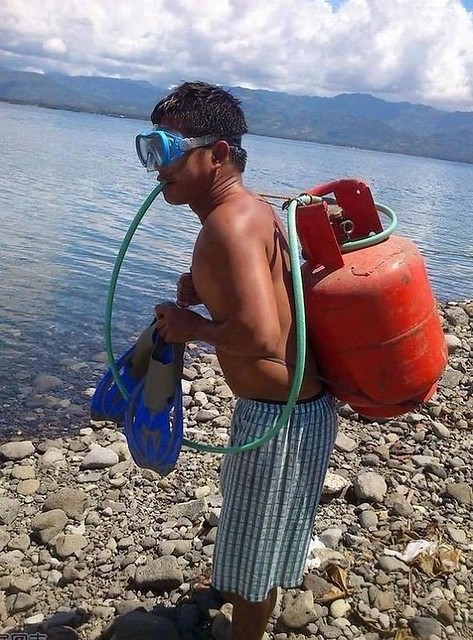As repeatedly stated above, the need for proper dive training cannot be over emphasized as lung injury (e.g. due to ascent while holding ones breath) is a real danger even at very shallow depth. In the following text though, I will describe equipment related dangers only.
Even if the home made breathing apparatus served canned breathing quality air (e.g. from a dive shop), you would still need to be able to build a pressure regulator that serves air exactly at ambient pressure. If your home made pressure regulator fails, someone dies.
If the breathing apparatus serves surface supplied air from a "low" pressure compressor through a hose, then the same precautions apply, and you must also make sure that the air is of breathing quality and does not contain carbon monoxide, carbon dioxide, oil, or other stuff. If the pump fails and the air starts to go back up along the hose (while the diver is at depth), then various unpleasant things could happen to the diver.
If you use an open bottom helmet, then overpressure is less of a problem as extra air can escape, but failure to pump adequately soon causes panic and carbon dioxide poisoning and hypoxia (and I am not saying that a sudden blast of 200 bar on top of ones head would be healthy, so manual pumps only). Also, stumbling and falling (or a failure of the pump) floods the helmet. In this case an inexperienced diver facing issues would panic, inhale water and drown. Finally, if the helmet is not well made but fails (e.g. the window shatters) then the diver is up for an unpleasant surprise.
I do not know what lubricants manual pumps use and what kind of oil or dust or other residue they leave in the air, so the air pumped might not be of the healthiest sort. The ancient manual pumps used with the Siebe-Gorman dress were made out of brass (I believe copper is antibacterial to some extent) and used vegetable oil as lubricant. I don't know how pure the air delivered was, but a $10 pump from China might not be as good...
Closed helmets come with even more hidden dangers (some of which are quite nasty).
I cannot guarantee that the above list would be exhaustive. There are probably many more dangers that I am unaware of. Hence, diving with home made diving equipment can be risky.
Attached you will find an image of historical diving using an open bottomed helmet and a manual air pump intended for car decks. The dive was a short demonstration dive only.






